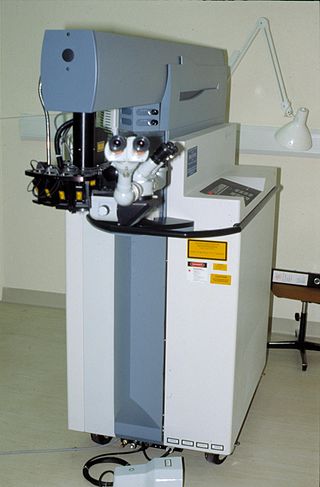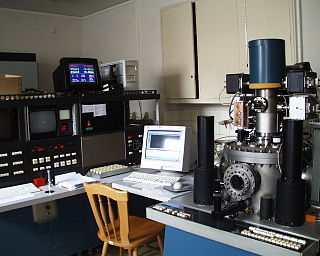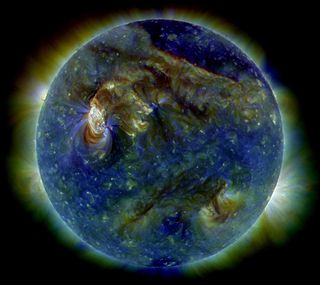Related Research Articles
Photolithography is a process used in the manufacturing of integrated circuits. It involves using light to transfer a pattern onto a substrate, typically a silicon wafer.

A photoresist is a light-sensitive material used in several processes, such as photolithography and photoengraving, to form a patterned coating on a surface. This process is crucial in the electronics industry.

An excimer laser, sometimes more correctly called an exciplex laser, is a form of ultraviolet laser which is commonly used in the production of microelectronic devices, semiconductor based integrated circuits or "chips", eye surgery, and micromachining.
A photomask is an opaque plate with transparent areas that allow light to shine through in a defined pattern. Photomasks are commonly used in photolithography for the production of integrated circuits to produce a pattern on a thin wafer of material. In semiconductor manufacturing, a mask is sometimes called a reticle.

Electron-beam lithography is the practice of scanning a focused beam of electrons to draw custom shapes on a surface covered with an electron-sensitive film called a resist (exposing). The electron beam changes the solubility of the resist, enabling selective removal of either the exposed or non-exposed regions of the resist by immersing it in a solvent (developing). The purpose, as with photolithography, is to create very small structures in the resist that can subsequently be transferred to the substrate material, often by etching.

Extreme ultraviolet lithography is a technology used in the semiconductor industry for manufacturing integrated circuits (ICs). It is a type of photolithography that uses 13.5 nm extreme ultraviolet (EUV) light from a laser-pulsed tin (Sn) plasma to create intricate patterns on semiconductor substrates.

The Multi-Spectral Solar Telescope Array (MSSTA) was a sounding rocket payload built by Professor Arthur B. C. Walker Jr. at Stanford University in the 1990s to test EUV/XUV imaging of the Sun using normal incidence EUV-reflective multilayer optics. MSSTA contained a large number of individual telescopes, all trained on the Sun and all sensitive to slightly different wavelengths of ultraviolet light. Like all sounding rockets, MSSTA flew for approximately 14 minutes per mission, about 5 minutes of which were in space—just enough time to test a new technology or yield "first results" science. MSSTA is one of the last solar observing instruments to use photographic film rather than a digital camera system such as a CCD. MSSTA used film instead of a CCD in order to achieve the highest possible spatial resolution and to avoid the electronics difficulty presented by the large number of detectors that would have been required for its many telescopes.

Extreme ultraviolet radiation or high-energy ultraviolet radiation is electromagnetic radiation in the part of the electromagnetic spectrum spanning wavelengths shorter than the hydrogen Lyman-alpha line from 121 nm down to the X-ray band of 10 nm. By the Planck–Einstein equation the EUV photons have energies from 10.26 eV up to 124.24 eV where we enter the X-ray energies. EUV is naturally generated by the solar corona and artificially by plasma, high harmonic generation sources and synchrotron light sources. Since UVC extends to 100 nm, there is some overlap in the terms.
Federico Capasso is an Italian-American applied physicist and is one of the inventors of the quantum cascade laser during his work at Bell Laboratories. He is currently on the faculty of Harvard University.

Multiple patterning is a class of technologies for manufacturing integrated circuits (ICs), developed for photolithography to enhance the feature density. It is expected to be necessary for the 10 nm and 7 nm node semiconductor processes and beyond. The premise is that a single lithographic exposure may not be enough to provide sufficient resolution. Hence additional exposures would be needed, or else positioning patterns using etched feature sidewalls would be necessary.

Anthony Michael Johnson is an American experimental physicist, a professor of physics, and a professor of computer science and electrical engineering at the University of Maryland, Baltimore County (UMBC). He is the director of the Center for Advanced Studies in Photonics Research (CASPR), also situated on campus at UMBC. Since his election to the 2002 term as president of the Optical Society, formerly the Optical Society of America, Johnson has the distinction of being the first and only African-American president to date. Johnson's research interests include the ultrafast photophysics and nonlinear optical properties of bulk, nanostructured, and quantum well semiconductor structures, ultrashort pulse propagation in fibers and high-speed lightwave systems. His research has helped to better understand processes that occur in ultrafast time frames of 1 quadrillionth of a second. Ultrashort pulses of light have been used to address technical and logistical challenges in medicine, telecommunications, homeland security, and have many other applications that enhance contemporary life.
The argon fluoride laser is a particular type of excimer laser, which is sometimes called an exciplex laser. With its 193-nanometer wavelength, it is a deep ultraviolet laser, which is commonly used in the production of semiconductor integrated circuits, eye surgery, micromachining, and scientific research. "Excimer" is short for "excited dimer", while "exciplex" is short for "excited complex". An excimer laser typically uses a mixture of a noble gas and a halogen gas, which under suitable conditions of electrical stimulation and high pressure, emits coherent stimulated radiation in the ultraviolet range.
In semiconductor manufacturing, the "7 nm" process is a term for the MOSFET technology node following the "10 nm" node, defined by the International Roadmap for Devices and Systems (IRDS), which was preceded by the International Technology Roadmap for Semiconductors (ITRS). It is based on FinFET technology, a type of multi-gate MOSFET technology.

Hakeem Muata Oluseyi is an American astrophysicist, cosmologist, inventor, educator, science communicator, author, actor, veteran, and humanitarian.
Deborah J. Jackson is an American physicist and Program Manager at the National Science Foundation, and a Fellow of the National Society of Black Physicists. She was the first African American woman to receive a Ph.D. in physics from Stanford University. She is an expert on "electromagnetic phenomena" with a research and development career that spans the full range of the electromagnetic spectrum from materials studies using hard x-ray wavelengths, to nonlinear optics and spectroscopy in the near-infrared, to the fielding of radio frequency instrumentation on deep space missions such as Cassini and Mars Observer.

Willie S. Rockward is a physics professor and has served as the chair of the department of physics and engineering physics at Morgan State University since August 2018. His research interests include Micro/Nano Optics Lithography, Extreme Ultraviolet Interferometry, Metamaterials, Terahertz imaging, Nanostructure Characterization, and Crossed Phase Optics. From 2018 to 2020 he was the president of the National Society of Black Physicists.
Peter J. Delfyett Jr is an American engineer and Pegasus Professor and Trustee Chair Professor of Optics, ECE & Physics at the University of Central Florida College of Optics and Photonics.
Regina Soufli is a Greek-American physicist and a staff scientist at Lawrence Livermore National Laboratory, in Livermore, California, where she works on the development and the characterization of materials and thin-film coatings for extreme ultraviolet (EUV) and X-ray applications. The results of her work is the heart of the reflective optics used in EUV lithography, the next-generation in semiconductor manufacturing technology, in satellites such as NASA's Solar Dynamics Observatory and NASA/NOAA's GOES-16 to GOES-19, or on optics for Free-electron lasers such as the Linac Coherent Light Source at SLAC National Accelerator Laboratory.
David Attwood is an American physicist and professor emeritus at the University of California, Berkeley, where he worked in the field of synchrotron radiation and free-electron lasers, developing X-ray microscopy techniques for research and for the industry. He is the author of a reference book on soft X-rays and extreme ultraviolet radiation.
Carmen S. Menoni is an Argentine-American physicist who is the University Distinguished Professor at Colorado State University. Her research considers oxide materials for interference coatings and spectrometry imaging. She is a Fellow of the Institute of Electrical and Electronics Engineers, American Physical Society, Optica, and SPIE. Menoni served as the President of the IEEE Photonics Society from 2020 to 2021.
References
- 1 2 3 4 "Keith Jackson's Biography". The HistoryMakers. Retrieved 2023-10-27.
- 1 2 Williams, Scott. "Physicists of the African Diaspora". Physicists of the African Diaspora. Retrieved October 27, 2023.
- 1 2 scyang (2017-10-03). "How Berkeley Lab Software Helped Lead to the 2017 Nobel Prize in Physics - Berkeley Lab". Berkeley Lab News Center. Retrieved 2023-10-27.
- ↑ Thompson, Garland (January 1, 2004). "The 50-Most Important African-Americans in Technology". US Black Engineer and IT. p. 25.
- 1 2 "IEEE Explore". IEEE . Retrieved 2023-10-27.
- ↑ "NSBP History - National Society of Black Physicists". nsbp.org. Retrieved 2023-10-27.
- ↑ "NSBP Fellows - National Society of Black Physicists". nsbp.org. Retrieved 2023-10-27.